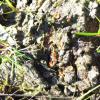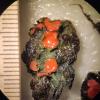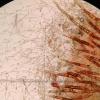
02-11-2014 16:04
 Beñat Jeannerot
Beñat Jeannerot
Adio to all,A question to Germans.I've seen a sign

01-11-2014 22:20
 Zuzana Sochorová (Egertová)
Zuzana Sochorová (Egertová)
Good evening, can this be something different than

27-10-2014 20:09
Peter ThompsonHello Everyone,I have found a Gibberella species w

31-10-2014 14:59
 Bernard Declercq
Bernard Declercq
Hi there,Collected on water-soaked rotten wood of

31-10-2014 14:16
Garcia SusanaHi:With this I do not know correctly interpret wha

07-10-2014 17:19
Can someone help with this Scutellinia. Found a gr

30-10-2014 16:34
 Alex Akulov
Alex Akulov
Fungicolous hyphomycete on Lasiosphaeria strigosa

30-10-2014 16:39
 Alex Akulov
Alex Akulov
Nice synnamatous fungus from the unusual substrat

29-10-2014 19:21
HI again I need your help again with these isolat
coprophilous Scutellinia
Warre Van Caenegem,
14-03-2025 23:29
Apothecia up to 5 mm
Hairs mostly bi- or trifurcated, sometimes simple, up to 600 µm, mostly between 300 and 500 µm, septated, the top of the hairs are hyaline,
Asci 205-240 x (12-)15-16 µm, 8-spored
Ascospores (16-)17-19(-20) x 10-12 µm, with regular spaced, low wrats
Found in Belgium, Antwerp, Mol, on 10 April 2024.
ITS has been sequenced, and matches 97,7% with Scutellinia sp. (Genbank Accession numbers MW540903.1 en MW540937.1), and 96,9% with S. fimicola (MW540964.1). The morphology does not match with S. fimicola, because of the smaller spores and the larger asci.
Are there any other fimicolous Scutellinia species known?
>Scutellinia_ITS
ACCCATCTGCGTACATTACCCGTTGCTTCCGCGAGGCAGTGATCTTCGATCACCTC
CCGACGATGGCTTGGGCCNTCCGGTGGGGAGCCCTCGTGAAAGGTTTACACCAA
ACCCTTGCATTTCTATGTCATCTGTCTGAAACTGTTAATAACAAATGTWAAAACTTT
CAACAACGGATCTCTTGGTTCTCGCATCGATGAAGAACGCAGCGAAATGCGATAA
GTAGTGTGAATTGCAGAATTCAGTGAATCATCGAATCTTTGAACGAACATTGCGCC
TCCTGGTATTCCGGGAGGCATGCCTGTTCGAGCGTCATTAATACCACACTCGAGT
CATTTTCGTGGCTCGGTCTTGGGAGAGGAGCGCAACTCGTCTGCCCTCCCTTCCG
AAATCCAATGGCGGAAAGCCCCACGTGCCCCGGCGTAGTAAGTCTTCTTTCGCTC
GGAACGTTTGGCGATCCTGCCGTGAACCCCCCACAAAATCATTTTACAGGTTGAC
CTCGGATCAGGTAGGGATACCCGCTGAACTTAAGCATA
Malcolm Greaves,
15-03-2025 10:04
Re : coprophilous Scutellinia
In the UK we have had at least 4 species which have been found on dung. Unfortunately none fit your specimen but it shows that at least some of the soil inhabiting species can also grow on dung.
Lothar Krieglsteiner,
15-03-2025 12:08

Re : coprophilous Scutellinia
my hyperborea/minor from the Alps that I want to re-examine soon was growing on cow dung, too.
I was surprised that it was definitely a Scutellinia and not a Cheilymenia.
I was surprised that it was definitely a Scutellinia and not a Cheilymenia.






